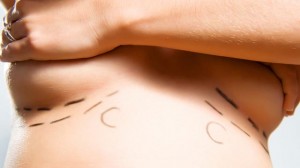Breast augmentation is not only one of the most popular plastic surgery procedures today—it’s also one of the most talked-about procedures. It seems to be that every week a new celebrity is featured on tabloid covers with questions about whether she’s undergone breast enhancement surgery. Unfortunately, all this conversation has also come with a variety of myths and rumors about the procedure, which can have a strong impact on women whose self-confidence could benefit greatly from breast augmentation. To help potential patients have an accurate understanding of the surgery, I’ve compiled and explained the truth behind some of the most common breast augmentation myths and misconceptions.
 Myth: Breast augmentation is only for women who want larger breasts.
Myth: Breast augmentation is only for women who want larger breasts.
Fact: While some patients want their breasts to be larger so that they are better-proportioned with the rest of their body, many women choose breast augmentation to improve the appearance of breasts that are tubular, asymmetrical, or have other irregularities.
Myth: The only way to make breasts larger is with implants.
Fact: While breast implants are typically the best way to get a more substantial improvement in breast size, in recent years, fat transfer has become an increasingly popular procedure. This surgery involves performing liposuction to remove unwanted fat from an area like the abdomen, flanks, or thighs. The fat is then purified and injected into the breasts to add volume. When it’s performed by an experienced board-certified plastic surgeon, fat transfer can provide a natural-looking enhancement for the breasts.
Myth: Breast augmentation leaves large, prominent scars.
Fact: While every surgery will leave a scar, I ensure that every breast augmentation patient’s incisions are placed as discretely as possible. Depending on the individual patient’s needs, the incision can be made under the arms, around the nipple, or within the natural crease below the breast. For patients who choose fat transfer for breast augmentation, scarring will be especially minimal, because they will only require small incisions at the liposuction site and injections into the breasts.
Myth: You will lose sensitivity in your nipples after breast enhancement.
Fact: Some patients do experience changes in sensitivity after breast surgery, but this is typically temporary, often fading within a few weeks or months after the procedure. Permanent loss of sensitivity is a very rare complication, especially when the surgery is performed by a board-certified plastic surgeon who specializes in breast procedures.
Myth: Breast implants will make your breasts look younger.
Fact: Breast augmentation focuses solely on increasing the size of your breasts, and it does not affect the youthfulness of their appearance. However, for patients who want their breasts to be both larger and raised to a more flattering height, we may be able to combine a breast augmentation with a breast lift to provide the more comprehensive results they’re looking for.
Myth: Silicone implants are dangerous.
Fact: While silicone breast implants were removed from the market in 1992 due to a lack of long-term data, they have since been studied and tested rigorously for safety, and as a result, the FDA again approved them for use in 2006. Since then, they have become increasingly popular. According to the American Society for Aesthetic Plastic Surgery, as many as 77% of all breast implants placed in 2014 were silicone.
Myth: It’s more difficult to exercise with breast implants.
Fact: After the body has healed appropriately, patients with breast implants should be able to exercise in the same way they did before their surgery. However, it’s important to follow your surgeon’s recommendations for when you can resume various types and intensities of exercise. Patients also need to remember to support their new breasts with an adequate sports bra during their workouts.
Myth: You won’t be able to breastfeed after breast enhancement.
Fact: Difficulty with breastfeeding is a potential complication of breast surgery, but only in rare cases. There are also steps we can take to minimize this risk, such as selecting where to place the incisions and inserting the implant below the chest muscle rather than on top of it.
Myth: Breast augmentation is a rather simple procedure, so any plastic or cosmetic surgeon can perform it.
Fact: While breast enhancement is a rather straightforward operation for those who have the necessary expertise, the results depend on the surgeon’s level of in-depth knowledge, training, and experience. Patients should be sure to look for a board-certified plastic surgeon (rather than a “cosmetic surgeon”), and preferably one with a wealth of experience in breast procedures.
Myth: It’s obvious when a woman has had breast augmentation.
Fact: While someone who knew you in the past may notice that your breasts are larger than they were a year ago, the field of plastic surgery has come a long way in making breasts look and feel especially natural. Patients who are concerned with results that are discrete can choose a breast size which is proportionate with the rest of their body and can discuss which methods and implants will look more like natural breasts.
There is no shortage of incorrect and outdated information floating around about breast augmentation, but the bottom line is that breast enhancement can be very different from one patient to another, so the most reliable source of information is a board-certified plastic surgeon who has conducted an exam and is familiar with the specific details of your situation. To start discussing whether breast augmentation is the right choice for you, schedule a consultation with me, Dr. Franklyn Elliott. Or, for more helpful information, follow me on Facebook, Twitter, and Google+.
 A facelift can rejuvenate areas including and above the jawline and chin, while a neck lift targets the neck below the chin.
A facelift can rejuvenate areas including and above the jawline and chin, while a neck lift targets the neck below the chin.
 Her breasts have changed since her last surgery.
Her breasts have changed since her last surgery. What is gynecomastia?
What is gynecomastia? Myth: Breast augmentation is only for women who want larger breasts.
Myth: Breast augmentation is only for women who want larger breasts. Keep your future cancer treatments in mind. Radiation can cause changes to both the scar around an implant and to the tissue if you choose autologous breast reconstruction (any of the techniques that use your own tissue), so knowing whether you’ll be undergoing future radiation will be helpful in discussing your options during your plastic surgery consultation.
Keep your future cancer treatments in mind. Radiation can cause changes to both the scar around an implant and to the tissue if you choose autologous breast reconstruction (any of the techniques that use your own tissue), so knowing whether you’ll be undergoing future radiation will be helpful in discussing your options during your plastic surgery consultation.



